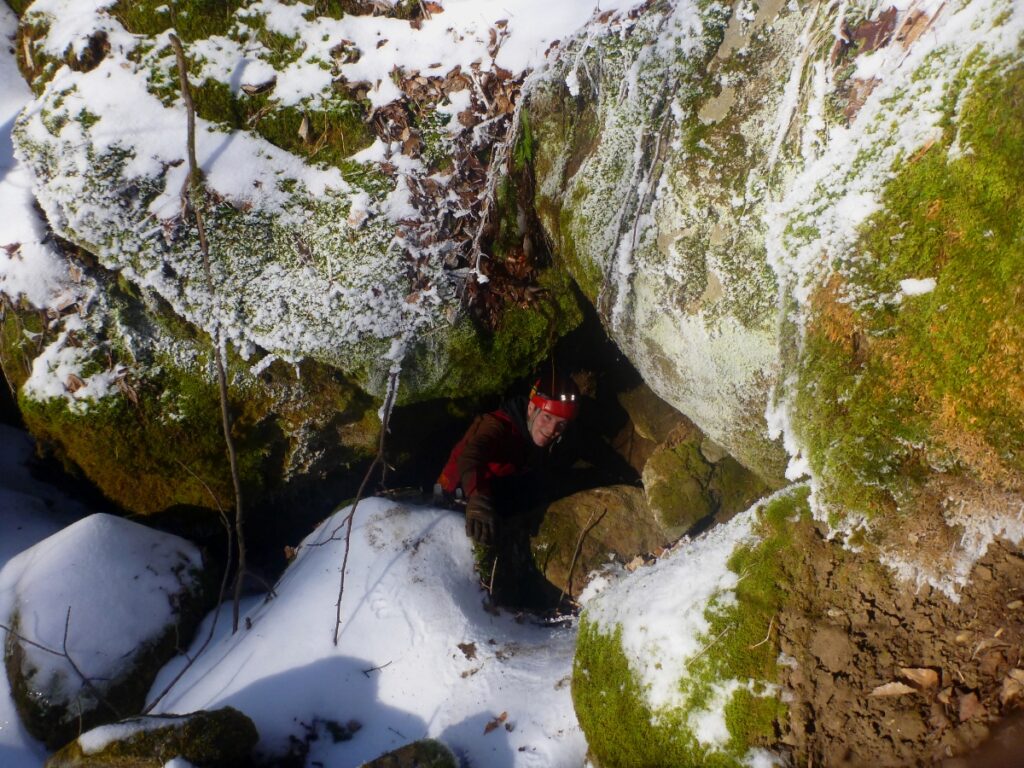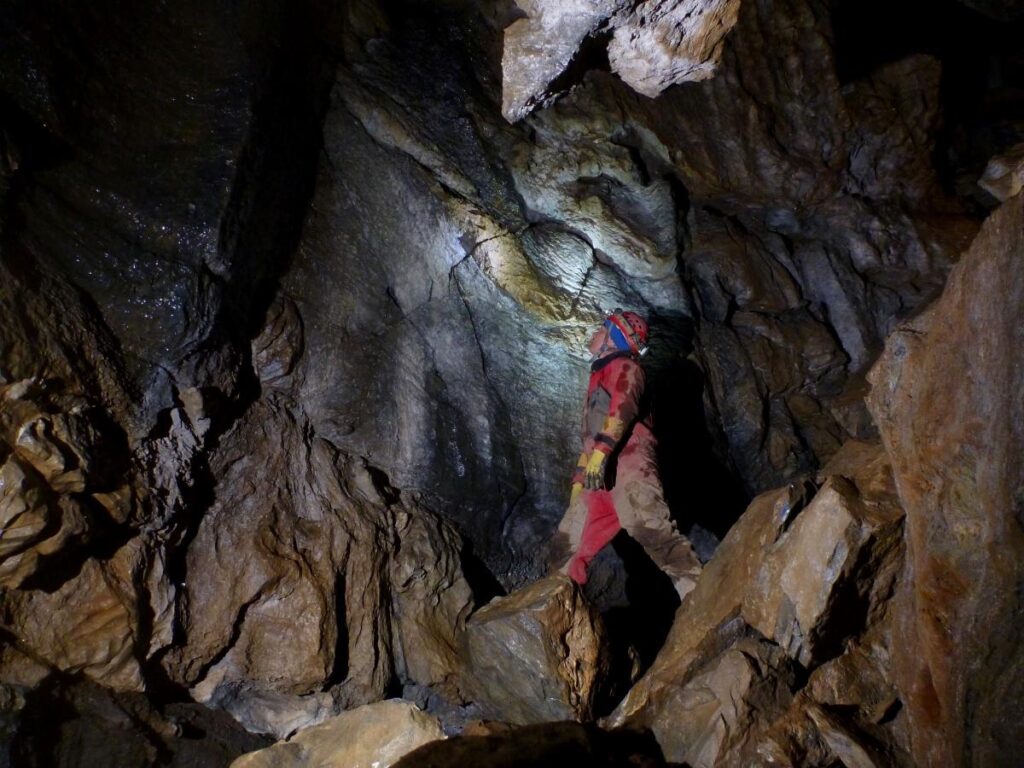Beware: You should never explore wild caves alone or without proper gear. Consider getting in touch with a Grotto of the National Speleological Society at www.caves.org or a qualified cave club. These groups are skilled and will train you. Without sufficient knowledge, preparation, and equipment, cave exploring can lead to serious injury or death.
The second least-populated state in the country, just after Wyoming, Vermont is also one of the smallest. While this might mean boredom to some, it also means peace and quiet. You can enjoy exploring some of the many caves you can find in Vermont, which we have a full list of here.
This state is special for a couple reasons. Vermont was the first state to abolish slavery, and the first to recognize same sex marriage. In addition, it carries over 12,000 years of history of indigenous peoples inhabiting the region.
Knowing that there’s a rich history behind it including indigenous peoples and colonists alike, it adds to the mystique of certain caves. Next time you’re in the state, be sure to check out some of these caves (or all of them) when you have a good opportunity.
Several of these caves are more advanced, requiring extended crawling and vertical ascent/descents. Be sure that you are bringing the right equipment before you go. We’ve got a full list of caving equipment on this site to help you find everything in one place.
With that said, let’s go see the caves in Vermont!
Aeolus Cave (Dorset Bat Cave)
Located 2,520 feet in the Taconic Mountains, this cave is mostly horizontal and made of variations of Columbian marble and Shelburne formations. Aeolus Cave is typically well known for housing a very large numbers of bats.
However, this number was reduced following a White-Nose Syndrome outbreak. White-Nose Syndrome a fungal disease known for reducing the bat population in the United States and Canada to a severe extent.
Before this outbreak, the Aeolus cave was noted for being the largest bat hibernaculum in the northeastern United States. In addition to being known for its bats, the Aeolus cave is the longest in Vermont.
The cave has a very spacious and accessible upper level, but as it gets lower it becomes more and more challenging with its many formations and tight spaces. Unfortunately, due to its large bat population, this cave is not currently open for visitation.

Carbide Cave
Discovered in the late 1990’s by Bob Dion, The Carbide cave is a horizontal cave made of mainly Sherman marble. is nicknamed for the carbide quarry inside of it, which occasionally has a small stream that runs through it.
Most of the upper level of the cave is dry, however. There is white marble with nodules of graphite and quartz, which gives it a unique look.
In addition to this this cave has cave pearls, which is rare for a cave in Vermont. The Carbide Cave is a horizontal cave made of mainly Sherman marble. It is also a Mount Holly complex. This cave is fairly easy to explore, so it is ideal for those new to spelunking or those who just want a new adventure.

Chimney Cave (SICO’s Cave)
This cave, which is made of mostly Bascom-Beldens marble and filled with Bascom formations, is characterized by high angles and steep climbs. It is a very steep passage that begins with a large room that leads to many areas you can climb and small rooms that are fairly easy to fit in.
Then, it abruptly ends in a debris choke.
Like several Vermont caves, Chimney Cave is home to many bats, and is often visited by scientists to conduct bat surveys. Due to its somewhat difficult layout, the Chimney Cave is a good place to explore for experienced cave divers. It will provide a challenge for those trying to sharpen their skills.

Easter Cave
Easter Cave is mainly horizontal, aside from a few short climbs. It consists of mostly Sherman marble and has a Mount Holly complex.
The cave has a few exposures of white banded marble, which gives the cave a distinct look.
Easter cave is a group of fractures, domes, and crawl areas which were not created or connected to existing water flow in the cave. It has 3 main entrances that hold sections, connected to each other by small spaces that house larger passages.
Many of the spaces in this cave have long stalactites, giving explorers an interesting example of the beauty of cave formations.

Falls Cliff Cave
Characterized by having unique marble formations, the Falls Cliff Cave is a vertical wet cave. Made of Bascom-beldens marble and filled with Bascom formations, it is noteworthy for its clean washed banded marble formations. Many are found in the lower levels of the cave.
This cave is mostly vertical, so it is moderately difficult to traverse. However, you do not need vertical gear to access it.

Johnston Cave (Hangover Pit)
The Johnston Cave (or Hangover Pit) is a vertical cave which is unique for being formed out of Winooski dolomite.
It has a small entrance to fit through at the beginning, but you can expect the rest of exploring this cave to be a breeze because it is very spacious.
After going through the entrance, there Is a 30-foot vertical drop, and a short crawl passage off to the side. This is definitely an exciting cave to explore for beginners, as it is very accessible, but be sure to pack ropes and vertical gear in order to safely visit it.

Morris Cave
One of New England’s largest caves, and one of the Northeast’s largest caves overall, The Morris cave is an excellent cave to explore. It is made of Colombian marble and houses many Shelburne formations.
The cave begins with about 600 feet of small passages or ‘filters’ to fit through. Each of these are known as the Cobble Crawl, the Wet Pinch, and the Last Pinch.
After you pass these, you can expect to see large, beautiful rooms filled with lakes and waterfalls.
This is one of the most popular caves in Vermont for professional and casual cavers alike, and for good reason. It is challenging to reach, but the wondrous underground scenery is sure to make it worth the adventure.
Mt. Horrid Talus Caves
This set of three talus (boulder) caves were discovered in the slopes of Mt. Horrid by Robert W. Carroll Jr.
These caves are different compared to most talu caves.
Most talu caves are somewhat bright and have small openings. These caves however, contain large dark rooms, accompanied by the occasional climb.
The rooms are filled with granitoid genesis rock, a common type of rock characterized by its unique grey layers. This group of caves are closed annually from March 15 to August 1st in order to protect peregrine falcons, which are an endangered species native to the area. The area may be left open, however, if falcons are not present.
To see if these caves are accessible during that time, you can call the Forest Service Rochester Ranger District at 1-802-767-4261.

Perseverance Cave
A popular cave known for its often wet, lightly banded classic Bascom-Beldens marble; the Perseverance Cave is a vertical cave that was first opened in 1998. However, it was not fully discovered until 1999. It is made of Bascom-Beldens marble and has many Bascom formations.
In addition to these formations, the cave has a unique patch of cloud-like formations. There are many vertical, free hanging pits, but there are three main ones which are 43, 77, and 78 feet long respectively.
These pits make the cave decently difficult to access, and you may need vertical gear in order to access it. Exploring here is difficult, making its name quite fitting. It is definitely one of the most challenging caves in Vermont.


Pittsford Ice Cave
The Pittsford Ice Cave is a high angle cave with a few steep climbs, making it a pretty easy cave to explore. It is made of mostly Quartzite and has lots of Dalton formations.
The Pittsford Ice cave is one of Vermont’s most popular talus caves, as it is easy to explore and has many beautiful ice formations in the winter that often hold until the summer, so they can be viewed for a good half of the year.
Its entrance is steep, but there is a ladder placed for easy access. Following this, there are many large boulders inside of what seems to be ravine.
Purgatory Pit
Infamous for its classic pit entrance, the Purgatory pit is the only known of its kind in Vermont. This vertical cave consists of Bascom-Beldens marble accompanied by many Bascom formations.
The Purgatory Pit opens with an 84-foot entrance into a large room. After this there are two smaller rooms, and a 15-foot pit. In order to reach the bottom of the cave, you have to fit through a tight crawl that’s 84 feet long.
After you manage to do this, you’ve reached the bottom of the cave. This cave has many small spaces, making it a healthy challenge for experienced cavers.


Tallow Cave
The Tallow cave is a vertical cave noteworthy for having copious amounts of ‘moon milk’. This is a white creamy substance found in many limestone and dolomite caves thought to be made by bacteria.
The entrance is a small room 65 feet into the face of a quarry, making it fairly easy to enter with vertical gear.
The cave has a short climb that leads into a series of rooms and two short pits that need vertical gear to descend into.
If you’re wondering, the Tallow cave is named after a carved date and name that was found at the far end of the cave.
The Vermonster Cave System
The Vermonster Cave System is the second longest cave in New England, and was discovered in 2012 by the Berkshire Area Diggers Association.
The cave consists of a group of usually wet stream passages, and a few short vertical drops.
The cave alternates between tight crawn spaces and large domes that sometimes even have passages that overlap, making it a challenging climb.
Rope and vertical gear is needed, but only in three places. This cave is not generally open for visitation.

Windy River Cave
Discovered in 2015 by the Berkshire Area Diggers association, the Windy River cave is a horizontal cave made of Beldens Marble and many Bascom formations. It is made of thin-bedded marble that is undeformed, which is unique for a cave in Vermont.
The Windy River Cave has many crawling spaces to explore. You’ll also see a stream passage of walking height, which is a rare layout for a cave in the area. This cave also has many beautiful, delicate rock formations, which cause it to be moderately difficult to traverse. This cave is privately owned, but it is accessible with permission from the owners.

Conclusion
Vermont is the sixth smallest state in the US, and yet it boasts a respectable list of caves. Which of these do you plan to visit first?
When you’re finished here, be sure to check out some of the nearby states for more caving adventures. Some states may have more caves than Vermont, but you may not see the same numbers of bats as you can here. We’ve listed these states below:
New York Caves
Massachusetts Caves
New Hampshire Caves
